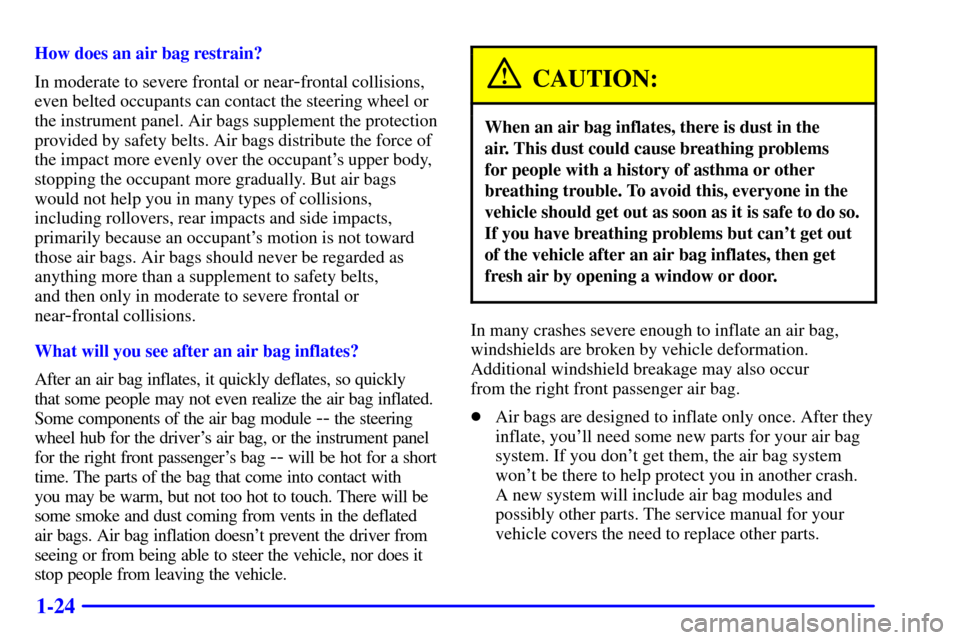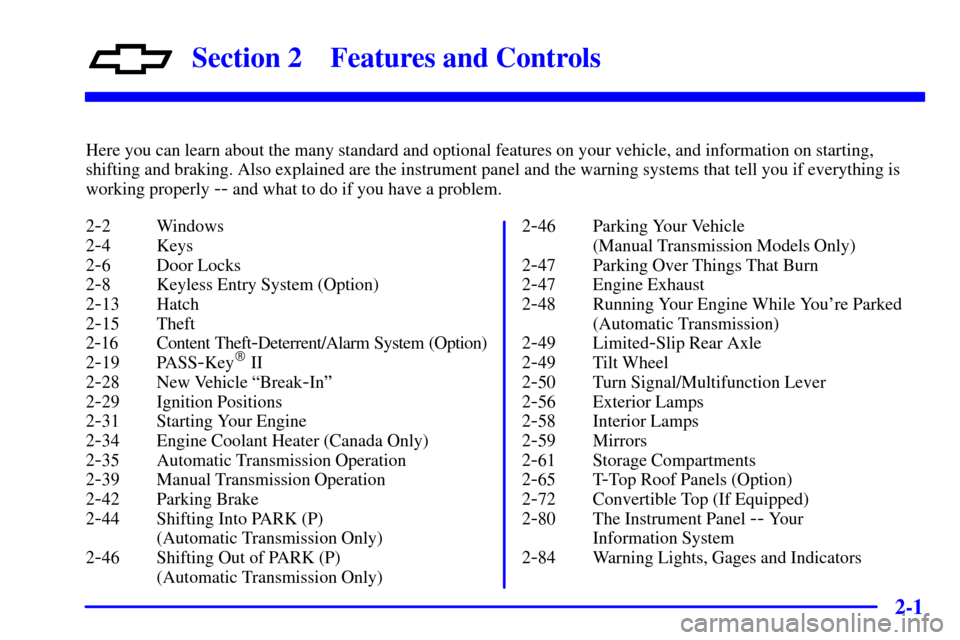Page 4 of 363
Table of Contents
Windows
Keys and Door Locks
Keyless Entry System (Option)
Hatch
Automatic Transmission
Manual Transmission
Parking Brake
Tilt Wheel
Turn Signal/Multifunction LeverWindshield Wipers
Cruise Control
Exterior and Interior Lamps
Mirrors
Storage Compartments
Cargo Cover
Accessory Power Outlet
Instrument Panel, Warning Lights and Gages Seats and Seat Controls
Safety BeltsAir Bag System
Restraint Systems for Children
Section
1
Section
2
Seats and Restraint Systems
Features and Controls
ii
Page 11 of 363

ix
For example,
these symbols
are used on an
original battery:
CAUTION
POSSIBLE
INJURY
PROTECT
EYES BY
SHIELDING
CAUSTIC
BATTERY
ACID COULD
CAUSE
BURNS
AVOID
SPARKS OR
FLAMES
SPARK OR
FLAME
COULD
EXPLODE
BATTERY
These symbols
are important for
you and your
passengers
whenever your
vehicle is driven:
CHILD
RESTRAINT
TOP STRAP
ANCHOR
DOOR LOCK
UNLOCK
FASTEN
SEAT
BELTS
POWER
WINDOW
AIR BAG
These symbols
have to do with
your lamps:
MASTER
LIGHTING
SWITCH
TURN
SIGNALS
PARKING
LAMPS
HAZARD
WARNING
FLASHER
DAYTIME
RUNNING
LAMPS
FOG LAMPS
These symbols
are on some of
your controls:
WINDSHIELD
WIPER
WINDSHIELD
WASHER
WINDSHIELD
DEFROSTER
REAR
WINDOW
DEFOGGER
VENTILATING
FAN
These symbols
are used on
warning and
indicator lights:
ENGINE
COOLANT
TEMP
BATTERY
CHARGING
SYSTEM
BRAKE
COOLANT
ENGINE OIL
PRESSURE
ANTI-LOCK
BRAKES
Here are some
other symbols
you may see:
FUSE
LIGHTER
HORN
FUEL
Vehicle Symbols
These are some of the symbols you may find on your vehicle. Also see ªWarning Lights and Gagesº in the Index.
Page 36 of 363

1-24
How does an air bag restrain?
In moderate to severe frontal or near
-frontal collisions,
even belted occupants can contact the steering wheel or
the instrument panel. Air bags supplement the protection
provided by safety belts. Air bags distribute the force of
the impact more evenly over the occupant's upper body,
stopping the occupant more gradually. But air bags
would not help you in many types of collisions,
including rollovers, rear impacts and side impacts,
primarily because an occupant's motion is not toward
those air bags. Air bags should never be regarded as
anything more than a supplement to safety belts,
and then only in moderate to severe frontal or
near
-frontal collisions.
What will you see after an air bag inflates?
After an air bag inflates, it quickly deflates, so quickly
that some people may not even realize the air bag inflated.
Some components of the air bag module
-- the steering
wheel hub for the driver's air bag, or the instrument panel
for the right front passenger's bag
-- will be hot for a short
time. The parts of the bag that come into contact with
you may be warm, but not too hot to touch. There will be
some smoke and dust coming from vents in the deflated
air bags. Air bag inflation doesn't prevent the driver from
seeing or from being able to steer the vehicle, nor does it
stop people from leaving the vehicle.
CAUTION:
When an air bag inflates, there is dust in the
air. This dust could cause breathing problems
for people with a history of asthma or other
breathing trouble. To avoid this, everyone in the
vehicle should get out as soon as it is safe to do so.
If you have breathing problems but can't get out
of the vehicle after an air bag inflates, then get
fresh air by opening a window or door.
In many crashes severe enough to inflate an air bag,
windshields are broken by vehicle deformation.
Additional windshield breakage may also occur
from the right front passenger air bag.
�Air bags are designed to inflate only once. After they
inflate, you'll need some new parts for your air bag
system. If you don't get them, the air bag system
won't be there to help protect you in another crash.
A new system will include air bag modules and
possibly other parts. The service manual for your
vehicle covers the need to replace other parts.
Page 46 of 363
1-34
A forward-facing child seat (C-E) provides restraint for
the child's body with the harness and also sometimes
with surfaces such as T
-shaped or shelf-like shields.
A booster seat (F-G) is a child restraint designed
to improve the fit of the vehicle's safety belt system.
Some booster seats have a shoulder belt positioner,
and some high
-back booster seats have a five-point
harness. A booster seat can also help a child to see out
the window.
Page 59 of 363

2-
2-1
Section 2 Features and Controls
Here you can learn about the many standard and optional features on your vehicle, and information on starting,
shifting and braking. Also explained are the instrument panel and the warning systems that tell you if everything is
working properly
-- and what to do if you have a problem.
2
-2 Windows
2
-4 Keys
2
-6 Door Locks
2
-8 Keyless Entry System (Option)
2
-13 Hatch
2
-15 Theft
2
-16 Content Theft-Deterrent/Alarm System (Option)
2
-19 PASS-Key� II
2
-28 New Vehicle ªBreak-Inº
2
-29 Ignition Positions
2
-31 Starting Your Engine
2
-34 Engine Coolant Heater (Canada Only)
2
-35 Automatic Transmission Operation
2
-39 Manual Transmission Operation
2
-42 Parking Brake
2
-44 Shifting Into PARK (P)
(Automatic Transmission Only)
2
-46 Shifting Out of PARK (P)
(Automatic Transmission Only)2
-46 Parking Your Vehicle
(Manual Transmission Models Only)
2
-47 Parking Over Things That Burn
2
-47 Engine Exhaust
2
-48 Running Your Engine While You're Parked
(Automatic Transmission)
2
-49 Limited-Slip Rear Axle
2
-49 Tilt Wheel
2
-50 Turn Signal/Multifunction Lever
2
-56 Exterior Lamps
2
-58 Interior Lamps
2
-59 Mirrors
2
-61 Storage Compartments
2
-65 T-Top Roof Panels (Option)
2
-72 Convertible Top (If Equipped)
2
-80 The Instrument Panel -- Your
Information System
2
-84 Warning Lights, Gages and Indicators
Page 60 of 363
2-2
Windows
CAUTION:
Leaving children in a vehicle with the windows
closed is dangerous. A child can be overcome by
the extreme heat and can suffer permanent
injuries or even death from heat stroke. Never
leave a child alone in a vehicle, especially with the
windows closed in warm or hot weather.
Manual Windows
Turn the window crank handle to open and close
each window.
Page 61 of 363
2-3 Power Windows (Option)
Switches on the driver's door control each window
when the ignition is on or when Retained Accessory
Power (RAP) is active. (See ªRetained Accessory
Powerº in the Index.)The switch for the driver's window has an express
-down
feature and is labeled AUTO. To lower the driver's
window completely, press the bottom of the switch and
release it after a second. To open the window partially,
activate the express
-down feature and press the top of
the switch when the window has lowered to the position
you want.
You can open the passenger's window any amount by
pressing the bottom of the switch for the passenger's
window and releasing it when the window has lowered
to the position you want.
To raise the window, press and hold the top of the switch.
Page 62 of 363
2-4
Keys
CAUTION:
Leaving children in a vehicle with the ignition
key is dangerous for many reasons. A child or
others could be badly injured or even killed.
They could operate the power windows or other
controls or even make the vehicle move. Don't
leave the keys in a vehicle with children.